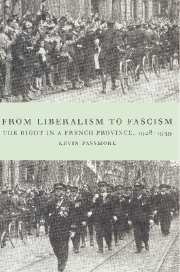Book contents
- Frontmatter
- Contents
- List of illustrations
- Preface
- List of abbreviations
- 1 Introduction
- 2 From France to the Rhône
- 3 Urban society in the Rhône
- 4 Rural society in the Rhône
- 5 The crisis of the right I: 1928–1932
- 6 The impact of the economic crisis
- 7 The crisis of the right II: 1932–June 1936
- 8 The Croix de Feu
- 9 The right and the Popular Front
- 10 Conclusion
- Appendix 1 Equations for multiple regressions
- Appendix 2 The conservative deputies of the Rhône, 1928–1940
- Select bibliography
- Index
7 - The crisis of the right II: 1932–June 1936
Published online by Cambridge University Press: 23 December 2009
- Frontmatter
- Contents
- List of illustrations
- Preface
- List of abbreviations
- 1 Introduction
- 2 From France to the Rhône
- 3 Urban society in the Rhône
- 4 Rural society in the Rhône
- 5 The crisis of the right I: 1928–1932
- 6 The impact of the economic crisis
- 7 The crisis of the right II: 1932–June 1936
- 8 The Croix de Feu
- 9 The right and the Popular Front
- 10 Conclusion
- Appendix 1 Equations for multiple regressions
- Appendix 2 The conservative deputies of the Rhône, 1928–1940
- Select bibliography
- Index
Summary
In the general elections of 1 and 8 May 1932 the left returned to power with 335 deputies against only 230 for the right. In the Rhône the writing had been on the wall since the previous year when the Radicals had won back the 3rd arrondissement constituency in a by-election following the death of the nationalist, Victor Augagnaur. In the general election Peissel, Bonnevay and Sallès all retained their seats, but Delorme was defeated. Nationally, however, the right had some cause for hope, for the Radicals and the SFIO had allied only for electoral purposes. Herriot, more concerned to reassure the banks than he had been in 1924, had rejected socialist proposals for a minimum programme. So he became prime minister at the head of a ‘concentration’ ministry of Radicals and centre-right with SFIO support. Herriot's moderation did not equip him to cope with growing domestic and international crises. Already in 1932 Weimar politicians had been demanding the right to re-arm. In October 1933 Hitler withdrew from the League of Nations. The fact that reparations had ended in 1932 in turn hindered elaboration of an effective response to the economic crisis. The Radicals, like the right, believed a balanced budget to be the precondition of economic recovery. Deflation provoked opposition from those who bore its brunt, such as civil servants, while others felt that cuts did not go far enough. Herriot fell in December. He was succeeded by ineffectual governments under Paul-Boncour (December 1932 to January 1933) and Daladier.
- Type
- Chapter
- Information
- From Liberalism to FascismThe Right in a French Province, 1928–1939, pp. 186 - 207Publisher: Cambridge University PressPrint publication year: 1997

